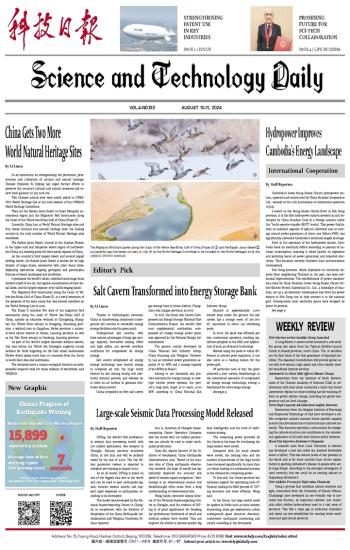
 Strengthening Patent Use in Key Industries
Strengthening Patent Use in Key Industries Promising Future for Sci-tech Collaboration
Promising Future for Sci-tech Collaboration China Gets Two More World Natural Heritage Sites
China Gets Two More World Natural Heritage Sites PHOTO NEWS
PHOTO NEWS Hydropower Improves Cambodia's Energy Landscape
Hydropower Improves Cambodia's Energy Landscape Salt Cavern Transformed into Energy Storage Bank
Salt Cavern Transformed into Energy Storage Bank WEEKLY REVIEW
WEEKLY REVIEW New Graphic
New Graphic Large-scale Seismic Data Processing Model Released
Large-scale Seismic Data Processing Model Released
In an instruction on strengthening the protection, preservation and utilization of cultural and natural heritage, Chinese President Xi Jinping has urged further efforts to preserve the country's cultural and natural treasures and renew their glamour in the new era.
Two Chinese natural sites were newly added to UNESCO's World Heritage List at the 46th Session of the UNESCO World Heritage Committee.
They are the Badain Jaran Desert in Inner Mongolia autonomous region and the Migratory Bird Sanctuaries along the Coast of the Yellow Sea-Bohai Gulf of China (Phase II).
Currently, China has 15 World Natural Heritage sites and four mixed (cultural and natural) heritage sites, the leading country in the total number of World Natural Heritage sites worldwide.
The Badain Jaran Desert, located in the Alashan Plateau in the hyper-arid and temperate desert region of northwestern China, is a meeting point for three sandy regions of China.
As the country's third largest desert and second largest drifting desert, the Badain Jaran Desert is known for its high density of mega-dunes, intersected with inter-dunal lakes, displaying spectacular ongoing geological and geomorphic features of desert landscapes and landforms.
It possesses the world's tallest, stabilized sand mega-dune (relative relief of 460 m), the highest concentration of inter-dunal lakes, and the largest expanse of so-called singing sands.
The Migratory Bird Sanctuaries along the Coast of Yellow Sea-Bohai Gulf of China (Phase II), is a serial extension of the property of the same name that was already inscribed on the World Heritage List in 2019.
The Phase II includes five sites of the migratory bird sanctuaries along the coast of Yellow Sea-Bohai Gulf of China, namely an estuarine wetland in Chongming, Shanghai; the Yellow River estuary in Dongying, Shandong province; a wetland area in Cangzhou, Hebei province; a national-level nature reserve in Dalian, Liaoning province as well as the Yalu River estuary in Dandong, Liaoning province.
As part of the world's largest intertidal wetland system, this area within the Yellow Sea Ecoregion supports crucial habitats for birds migrating on the East Asian-Australasian Flyway which spans more than 20 countries from the Arctic to South-East Asia and Australasia.
The wetlands serve a unique ecological function as indispensable stopover sites for many millions of waterbirds, said UNESCO.

 Next
Next



